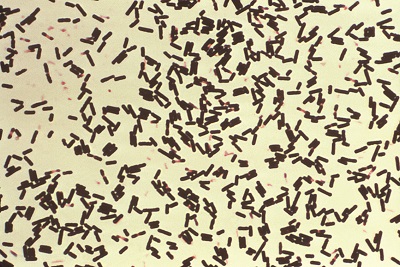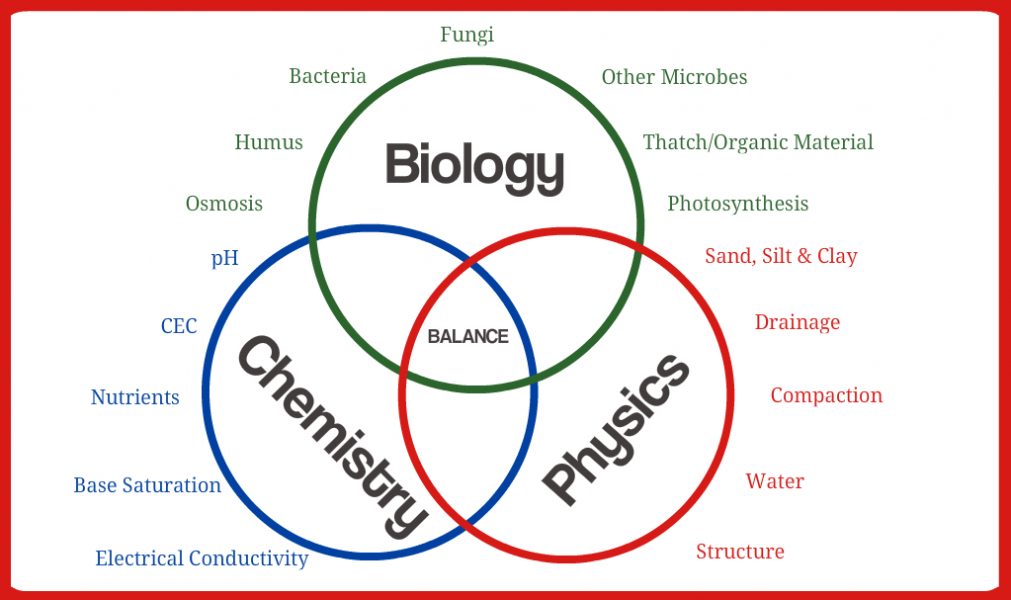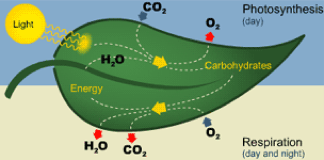A phenomenon I’ve termed the Circle of Decline describes an interconnected trail of symptoms that are commonly found on bowling greens that aren’t performing well and that are usually a pig to manage. It can become a perpetual chain of events that go on right under our feet that ensures that many bowls greens never perform consistently well regardless of how many innovations in machinery and products are thrown at them year after year.
Simply put, the Circle of decline looks like this:

You will see from this, that much of what goes wrong with bowling greens is due to the work we greenkeepers have been doing for decades followed by the work we do to try to correct the problems. We get fungal disease such as fusarium on the green, so we spray fungicide. We have a build up of thatch due to a low fungal population in the soil (fungi degrade and recycle thatch naturally), so we get more disease. The soil nutritional system breaks down due to a lack of microbial life in the soil so we have to use more mineral fertiliser to try to get some growth. The salt in the fertiliser makes the soil acidic and reduces aerobic soil life, meaning that we need to put on more fertiliser to make up for the lack of natural soil fertility. We need to add more water to make this fertiliser work, so reducing the aeration porosity of the soil which leads to compaction. We get more disease and so it goes on. I’m sure you get the picture by now.
One inevitable result of this process is that the green will by now be dominated by Poa annua/Annual Meadowgrass, which is completely unsuitable for producing a high performance bowling surface. This is no accident, as the situation we have created can only be suitable for annual plants. The soil will by now be anaerobic and lacking in microbial life and this type of soil can only support annuals and not the fine perennials needed for fine bowling surfaces.
So what can be done?
……to reverse decades of damage and return our greens to rude health and high performance?
Luckily, this is much less difficult than it might seem, but it takes a change of attitude and approach to greenkeeping to achieve it.
The good news is that there is no guesswork involved and no questionable practices. It’s tried and tested and not experimental in any way, but it is very very different to what goes on at most bowls clubs at the moment. It requires us to get back to nature, not in a Good Life, comedic way, but by applying a program of work that is rooted very simply in science and ecology.
How grass works naturally.
Nature works in a very efficient way and the process of colonisation of new, bare ground by plants is a great example of this. The progression of plant species has evolved so that any bare ground is first dominated by annual seeding grasses like Poa annua and tap rooted weeds like dandelions. In a completely natural environment the next stage will see perennial grasses such as Festuca (fescue) and Agrostis (bent) take over from the annuals, before eventually giving way to shrubs and eventually forests.
In climates where there are plentiful grazers like sheep, deer and cattle, grasslands will develop and the progression will largely stop with perennial grasses becoming the dominant plants for the
long term. On bowling greens, the grazers are replaced artificially by the greens mower and greenkeeper, except that in many cases we have regressed back to a sward dominated by the annual weed grass Poa annua and we’ve seen that this is due to the self inflicted Circle of Decline. It’s hard to admit, but we’ve largely been following inappropriate maintenance programs for decades based on the assertion that we can control everything that goes on under our feet; symptoms management in other words.
Due to this erroneous and in many cases unnecessary maintenance, we have in many cases unwittingly caused the soil beneath our greens to become barren and inert, making the surface week and susceptible to ingress of annuals like Poa annua.
Turning the Tide
Fortunately, it is possible to turn this situation around predictably and without too much drama. And although you’ve probably heard lots of scary stories about how you will need to first put the Poa annua under enormous stress before overseeding with fescue/bent seed, this isn’t necessary either.

It might sound too good to be true, but you can quite easily turn your green back into a fine, firm surface dominated by the fine perennial grasses, without doing anything questionable with pesticides that would surely lose you your job as greenkeeper. It is possible to convert playing surfaces from predominantly Poa annua to predominantly fine grasses without stressing the grass and the solution lies in the life in the soil itself.
What causes perennial grass domination as opposed to annual grass domination of the rootzone?
The supply of the main fertiliser elements (commonly called plant nutrition) is driven by soil biology. The micro-life in the soil makes nutrients, the building blocks of plant tissue, available in plant useable form. As the nutrient requirements for plant species above ground changes so does the microbial life underground.
You might remember from my earlier articles that the plants are producing glucose for energy during photosynthesis and all of that energy is used by the plant to grow and live. Our fine perennial grasses release about half of this energy above ground in the stem and leaves and this feeds the above ground food chain like grazers (green mowers!). Below ground they release the remaining 50% of the energy they produce which feeds the soil food chain of bacteria, fungi, protozoa, nematodes, arthropods and worms, or the soil food web, as it’s commonly referred to.
The Free Fertiliser Factory
Beneath our feet, there is the most remarkable factory where fertiliser for our turf is essentially produced for free, but only if the soil is working properly. In simple terms bacteria eat the proteins, sugars and carbohydrates that leak from the roots of the plants. Some Fungi suck up the juice exuded by the grass roots, but most live on the more woody cellulose and lignin found in thatch… Yes, they actually Eat Thatch, or Public Enemy Number 1 as we know it!
It as a jungle down there and in true jungle style, these bacteria and fungi become food themselves for predatory microbes including nematodes and protozoa. These predators excrete ammonium, which is then converted to nitrate by bacteria in well aerated soils. Nitrate can be used directly by
the plants and so this amazing cycle of growth and decay continues, producing everything needed by the plants in terms of soil nutrients.
When I devise greenkeeping programs for my clients, I recommend that they apply roughly the equivalent of 100kg/Ha (1 Hectare = about 6-7 bowling greens) of Nitrogen per annum during the transition period when the green is going from sick to well. However, a healthy, microbe rich green with 100% fine perennial grass will easily produce 50kg/Ha of Nitrogen naturally, just by breaking down the thatch that is produced by the growing plants. And of course if the thatch is being eaten, it isn’t building up into a smelly, spongy layer on the surface. This also means that later in the process of transformation, the fertiliser inputs needed will decrease dramatically. Into the bargain there will be no need for fungicides when the soil and turf are in healthy condition.
How to Get Started on a Performance Greens Program.
Getting the ball rolling on a this is easy and you will save money into the bargain while you watch your green improving.
Get the Kettle On!
The first thing to do is to set yourself up to carry out a baseline greenkeeping program based on promoting soil health. In place of inorganic, salt laden artificial fertilisers, you will be using Bio- Stimulants and Bio-Liquid Fertilisers and alongside these you will be applying Compost Tea.
In the early stages of transition to such a program greens will normally require further corrective measures to help the process get started properly such as correcting underlying imbalances in the Cation Exchange Capacity of the Soil, for which I would normally undertake a thorough soil analysis and make recommendations as part of the comprehensive report and schedule I provide my clients
But what is Compost Tea?
Tea is a bit of a misnomer to start with as what we are making is more akin to a soup. Instead of carrots, leeks and lentils though, this particular soup’s main ingredients are a mass of microorganisms (microbes) which are naturally found in a healthy soil. The term “soil microbes” is a catch all description for a variety of different microorganisms which, in naturally occurring healthy soils include many billions of bacteria, billions of fungi, millions of protozoa and nematodes, all of which have their own roles in the bowling green ecosystem.
The word tea here is used more to illustrate how the brew is made. It’s very much like making tea. We use a brewer (teapot) and the initial microbe population of the final brew are contained within a compost mix, in what is essentially a big teabag. During the compost tea brewing process these aerobic microbes are encouraged out of the compost teabag into the water in the brewer.

Given the right conditions these soil microbes replicate and grow in number very rapidly and this is the reason for the tea brewing process, to make a spray solution that is abundant in beneficial soil microbes. To encourage this rapid upscaling in the microbe population we add a food source for them to the tea brewer. We encourage a fungi dominated tea for perennials like bentgrasses (Agrostis) and fescues (Festuca).
In the case of compost tea, brewing describes the constant oxygenation and agitation of the tea mix by means of a special pump. The added oxygen and food source ensures that the microbe population explodes and multiplies many times over. When the brew is ready it is filtered into the sprayer, diluted and then applied to the turf directly.
On greens that have been managed in the conventional way for any length of time i.e. using pesticides and inorganic fertilisers, it’s likely that the soil microbe population will be significantly depleted. There might also be gaps in the eco-system, essentially “missing microbes”. Compost Tea provides a fresh population of the full range of microbes to bolster existing populations and even re-establish missing ones. Through repeated applications of your Compost Tea these new microbes will establish and replicate. The benefits of this full and abundant population of soil microbes will be manifold as their specific enzymes and toxins act in the soil to encourage plant health for the very species we must promote fro high performance.
Even in relatively healthy greens, where thatch is under control and a more natural greenkeeping program is already used, Compost Tea provides a wonderful probiotic boost, maintaining microbe diversity and helping to compensate for microbes lost through predation (it’s a jungle under your feet!).




